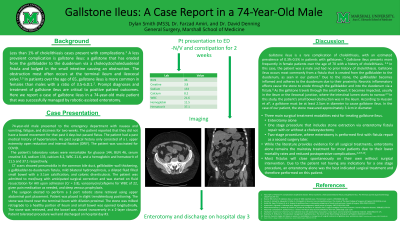General Surgery
Category: Quickshot Oral Session 25
Quickshot Oral : Quickshot Oral Session 25
GALLSTONE ILEUS: A CASE REPORT IN A 74-YEAR-OLD MALE
Tuesday, February 14, 2023
7:00am - 8:00am East Coast USA Time


Dylan Smith, BS, MS
MS3
Marshall School of Medicine, United States
Dylan Smith, BS, MS
MS3
Marshall School of Medicine, United States
Presenter(s)
Principal Contact(s)
Objectives: Gallstone ileus is a rare complication of complicated gallbladder disease. Typically the result of a cholecystocholeduodenal fistula, a gallstone enters the small bowel and impacts in the small intestine causing an obstruction. The obstruction most often occurs at the ileocecal valve. In this case, a 74-year-old male presented to the emergency department with nausea, vomiting, and constipation for 2 weeks. CT revealed pneumobilia and a 3.1cm calcified mass in the terminal ileum just before the ileocecal valve.
Three main surgical treatment modalities exist for treating gallstone ileus. One of the treatments is an enterotomy alone. Another treatment is a one stage procedure that includes stone extraction via enterotomy fistula repair with or without a cholecystectomy. A third option is to perform the two-stage procedure, where enterotomy is performed first with fistula repair as a second surgery later. While the literature provides support for all surgical treatments, enterotomy alone remains the mainstay treatment for most patients due to low mortality rates and reduced postoperative complications. This patient was successfully treated with a robotic assisted enterotomy alone without complications.
Methods:
Results:
Conclusion:
Three main surgical treatment modalities exist for treating gallstone ileus. One of the treatments is an enterotomy alone. Another treatment is a one stage procedure that includes stone extraction via enterotomy fistula repair with or without a cholecystectomy. A third option is to perform the two-stage procedure, where enterotomy is performed first with fistula repair as a second surgery later. While the literature provides support for all surgical treatments, enterotomy alone remains the mainstay treatment for most patients due to low mortality rates and reduced postoperative complications. This patient was successfully treated with a robotic assisted enterotomy alone without complications.
Methods:
Results:
Conclusion:

